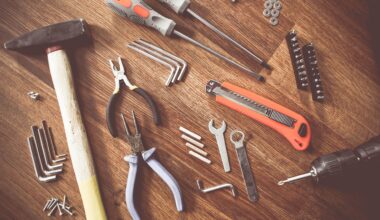Gear Packing Checklist for Triathlon Cycling Events
Participating in a triathlon can be thrilling and demanding, requiring meticulous preparation from gear list to execution. The key to enjoying your cycling segment lies in packing smartly. Begin by organizing your essential cycling gear, ensuring you have all items needed for a seamless race day. Make a foundational list that includes your bicycle, helmet, and cycling shoes, as these are crucial for your performance. Additionally, consider packing protective gear like glasses and gloves to enhance your comfort and safety during the event. For longer events, proper nutrition will play a vital role. Include energy gels, bars, and hydration packs to keep you fueled. Don’t forget other essentials such as a spare tube, pump, and basic repair tools in case of an emergency. Having these items will ensure you are prepared to handle unexpected situations. Planning ahead is necessary, so check your gear multiple times before race day. Bringing a small first-aid kit can also save you in case of minor injuries. Ultimately, ensure your packing is thorough, as being prepared can make the difference between a memorable race and a challenging experience.
Once you’ve gathered all your primary gear, it’s time to tackle clothing options. For a successful triathlon cycling leg, your outfit choice impacts performance and comfort. Opt for a breathable tri-suit that minimizes chafing, allowing for mobility and support. Layering garments appropriately helps regulate your body temperature throughout the race duration and transitions. Remember to include a lightweight jacket if weather conditions appear unpredictable, providing protection against rain or wind. Cycling shorts are also essential, providing padding to combat discomfort during long rides. Select moisture-wicking fabric to keep sweat away from your skin to prevent irritation. Socks may seem trivial, but they should fit snugly with no extra fabric. This prevents blisters and enhances comfort. It’s wise to include an extra pair, just in case. Footwear also deserves attention; choose shoes that are compatible with your pedals and can be easily slipped on during transitions. Ensure your shoes are broken in, so you avoid unnecessary discomfort on race day. Lastly, don’t forget your race number. Find a secure place to attach it, ensuring visibility for tracking purposes during the event.
Transportation and Storage
Your bike is a significant investment and essential part of your triathlon experience; therefore, proper transport and storage are fundamental. Utilize a high-quality bike bag or case to ensure that your bike remains undamaged throughout travel. Make sure it provides adequate cushioning and support while also allowing for easy transportation. Upon arrival at the venue, designate a clear space for setting up your gear. Understanding the designated area before the race helps in creating a smooth transition practice. Keep an eye on the weather forecast leading up to the event day. It may determine how you pack your gear accordingly. If rain is expected, solid waterproof gear becomes indispensable while packing additional cushioning for your bike. Also, consider securing your belongings. Using a lock, or resource like a bike-safe storage area provided by some events can provide peace of mind. It’s essential to not overpack; carry only what you require for riding demos and the race to avoid clutter. Each item has a purpose, so practice organization, making your race day experience more enjoyable.
Nutrition is an essential part of performance during a triathlon cycling event. Plan your meals and snacks meticulously before and during the race. Carbohydrate-loading in the days leading up to the event boosts your energy reserves; helpful foods include pasta, oats, and rice, which provide long-lasting energy. Hydration also plays a critical role; start drinking water well ahead of race day to ensure proper hydration levels are met. Opt for electrolyte supplements in your hydration system to maintain vital balance during strenuous activity. On the race day itself, prioritize energy gels, bars, or chews to refuel while biking. Practice consuming these during training rides to determine what works best for your stomach. Include up to 2 water bottles in your frame or pack for easy access during the race. If the event provides refreshment stations, familiarize yourself with their locations ahead of time. Post-race hydration is equally crucial; rehydrate immediately afterward to aid recovery. Snacks like bananas or recovery shakes can replenish lost nutrients quickly. Tabulating your nutritional strategy helps optimize performance and enhances overall enjoyment during the event.
Bike Maintenance Tips
Maintaining your bike in optimal condition prior to the triathlon cycling event is paramount. Regular bike maintenance ensures smooth operation and enhances your overall performance. Prior to race day, take time to perform a thorough inspection of your bike. Check tire pressure and tread; ensuring proper inflation reduces the risk of punctures. Lubricate the chain and gears to facilitate seamless shifting and prevent premature wear. Moreover, evaluate brake pads for wear and replace them if necessary; this is essential for safety throughout your race. Cleaning your bike removes dirt and debris that could affect performance and longevity. Ensure your derailleurs, cables, and handlebars are in excellent condition to guarantee efficient operation as you maneuver through various terrains. Lastly, enlist a professional bike check at your local shop if you’re unsure about any components. Having experts address your bike maintenance issues can save you from difficulties on race day. Familiarize yourself with basic repairs, such as changing a flat tire or adjusting brakes, which can be vital during the event. A well-maintained bike will not only enhance your confidence but also contribute significantly to your race performance.
Transitioning between different segments of a triathlon can make or break your performance. Preparing for this crucial stage requires strategic planning and practice. To enhance your transition time, first establish a systematic organization system. Set up your transition area with everything laid out for quick access—arrange your gear so items are placed within reach. This organization includes positioning your cycling shoes, helmet, and sunglasses in a logical order for efficiency. Practicing your transitions during training can help reduce anxiety and ultimately save time. Maintaining composure throughout the event will help you focus as you swiftly switch gear. Consider employing a number belt for your race number to mitigate additional movements during transitions. Understand the path you will take from the swim exit to your bike, as this visualization can aid in reducing hesitancy and speeding up your processes. Familiarizing yourself with the venue layout also equips you for a smoother journey between segments. Ultimately, the key to successful transitions lies in preparation, implementation, and maintaining focus to perform effectively at race time.
Final Checklist Before Race Day
As race day approaches, it’s beneficial to prepare a final checklist for all your gear and necessities. Review your complete pack list to ensure you didn’t overlook any items, maximizing your readiness. Itemize essentials like your bike, helmet, shoes, and nutrition supplies. As you go through your checklist, pay attention to the condition of all equipment; any damaged item should be replaced immediately to avoid issues on race day. Don’t forget your transition bag with clothing essentials, while preparing a special bag for after the race is also wise. Including a warm blanket or change of clothes can enhance recovery post-race. Essentials like sunscreen, towels, and toiletries should also be included, ensuring a comfortable experience. If the event offers a pre-race briefing, attendance is strongly suggested to stay informed about any last-minute changes. Prepare mentally by reviewing your goals and strategies for the race. Familiarize yourself with the course and prepare for any anticipated challenges. A final mental checklist reinforces confidence, empowers preparation, and enhances focus as you gear up for the triathlon cycling event.


